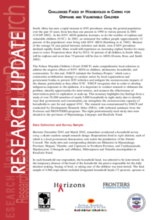South Africa has seen a rapid increase in HIV prevalence among the general population over the past 10 years, from less than one percent in 1990 to twenty percent in 2001. As the HIV/AIDS epidemic increases, so do the number of orphans and vulnerable children (OVC). In 2002, an estimated five million people (approximately 12 percent of the population) were living with HIV/AIDS. Because of the average 10-year period between infection and death, even if HIV prevalence declined rapidly, South Africa would still experience an increasing orphan burden for many years to come. Projections show that by 2010, 16 percent of all children in South Africa will be orphans and more than 70 percent will be due to AIDS.
The Nelson Mandela Children’s Fund (NMCF) seeks comprehensive local solutions to address the negative effects of HIV/AIDS on children, adolescents, households, and communities. To this end, NMCF initiated the Goelama Project, which uses a community mobilization strategy to catalyze action by local organizations and government bodies to prevent HIV infection and mitigate the socioeconomic impacts of the disease, particularly as they affect OVC. NMCF recognizes that in order to develop indigenous responses to the epidemic, it is important to conduct research to delineate the problem, identify opportunities for intervention, and measure the effectiveness of interventions prior to replication or scale-up.
In response to this need for information to guide appropriate action, researchers conducted a survey to investigate the challenges faced by households caring for orphans and vulnerable children in eight (predominantly rural) study sites in the provinces of Mpumalanga, Limpopo and KwaZulu Natal between December 2001 and March 2002 using a cluster random sample research design. This summary highlights key findings from this study, which includes the responses of over 29,000 members of nearly 5,000 households. The findings are used to identify six key ways that government and communities can strengthen the socioeconomic capacity of households to care for and support OVC.
©The Population Council Inc.

